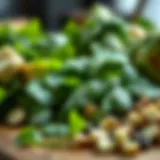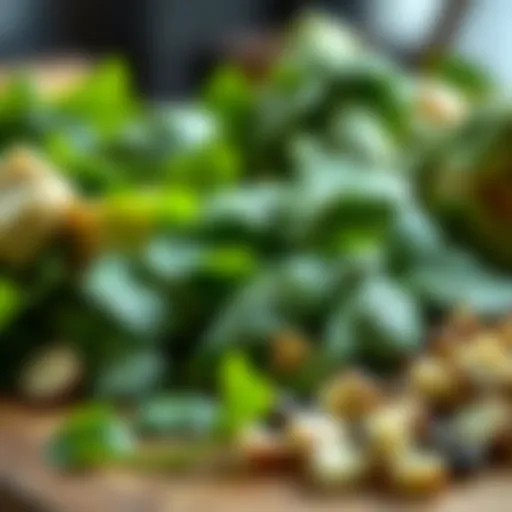Essential Ingredients for Perfect Macaroni Salad


Intro
Macaroni salad is a beloved dish, often associated with picnics and summer gatherings. Its charm lies in its versatility and the ability to customize to personal tastes. Understanding the essential ingredients is key to making a delicious macaroni salad. From choosing the right pasta to balancing flavors, this guide offers in-depth exploration into what creates the perfect dish.
Ingredients Breakdown
Primary Ingredients
At the heart of any macaroni salad is the pasta. Traditionally, elbow macaroni is the choice, but other shapes may offer unique textures. The dough's size allows for a delightful mix with other components.
The second key ingredient is the dressing. Most commonly, a mayonnaise base is used. This, combined with vinegar and mustard, provides a creamy texture with a bit of tang. Salt and pepper are also essential for enhancing flavors.
Optional Ingredients
While the basics are a great foundation, optional ingredients can elevate your dish. Consider adding celery for crunch, and red onion for a bit of sharpness. Some might include hard-boiled eggs, which add richness. Furthermore, pickles or relish can introduce a zesty note.
For those who enjoy a little sweetness, diced apples or grapes can make an interesting contrast with the savory elements.
Essential Kitchen Tools
To successfully prepare macaroni salad, a few tools can facilitate the process:
- A large pot for cooking pasta.
- A colander for draining.
- A mixing bowl for combining all ingredients.
- A whisk or spoon for mixing the dressing thoroughly.
Step-by-Step Preparation
Prepping the Ingredients
Preparation begins with cooking the elbow macaroni. Follow the package instructions, taking care to avoid overcooking. Once cooked, drain and rinse under cold water to halt the cooking process, preventing mushiness.
While the pasta cools, chop any desired vegetables, such as onion and celery. Prepare the dressing by combining mayonnaise, vinegar, mustard, salt, and pepper in a separate bowl.
Cooking Techniques and Methods
The cooking method for the pasta is straightforward, but attention should be given when mixing one’s salad. It’s important to avoid breaking the pasta while folding in other ingredients. Gently toss everything in the mixing bowl after preparing the dressing.
Assembly and Presentation Tips
When assembling, ensure even distribution of all ingredients. Presentation can also enhance enjoyment. Consider using a serving bowl that contrasts with the salad’s colors. A sprinkle of fresh herbs like parsley on top can also add visual appeal.
Dietary Considerations
Gluten-Free Options
For those with gluten sensitivities, gluten-free pasta is widely available. Ingredients should be double-checked to ensure they meet dietary needs.
Vegetarian and Vegan Substitutes
Substituting the mayonnaise is an option for vegans. Many brands offer vegan mayo made from plant ingredients. It’s essential to select a product with flavor that aligns with the rest of the dish.
Nutrition Facts & Nutritional Considerations
Macaroni salad may be high in calories due to the mayonnaise. Portion control is critical. However, incorporating vegetables increases fiber and vitamins. Understanding one’s dietary restrictions and nutritional needs can help create a balanced dish.
Variations and Customizations
Flavor Enhancements
Consider adding herbs like dill or basil for fresh, aromatic flavors. Bacon bits or cheddar cheese can provide a hearty boost, but should be used sparingly to not overwhelm the dish.
Alternative Cooking Methods
Some prefer baked macaroni salads, where ingredients are combined and baked until golden. But be cautious; this changes the dish’s traditional authoritative taste.
Pairing Suggestions
Macaroni salad pairs well with grilled items. Barbecue chicken or hot dogs are popular companions. For drinks, a light white wine or iced tea complements the flavors nicely.
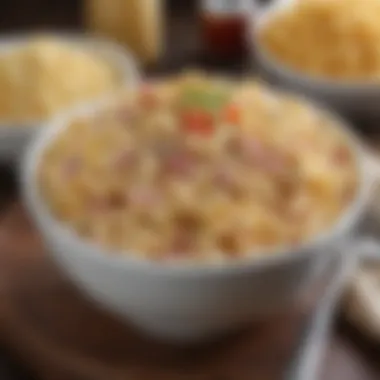

Common Questions and Answerss and Troubleshooting
Frequently Asked Questions
One often asked question is, "How can I keep macaroni salad from getting soggy?" One solution involves undercooking pasta slightly and using less dressing until serving.
Common Mistakes to Avoid
A frequent error is skipping rinsing pasta after cooking. Rinsing prevents stickiness.
Solutions to Potential Problems
If the salad tastes bland, add more salt and vinegar gradually. Taste is key here, so adjust seasonings until satisfied.
Prelude to Macaroni Salad
Macaroni salad stands out as a quintessential dish that symbolizes comfort and versatility. Understanding the foundation of this dish is crucial for both novice cooks and culinary enthusiasts. The macaroni salad not only serves as a delicious side dish but also holds a place in numerous culinary traditions across the globe. Its adaptability allows for a diverse range of ingredients, ensuring that each version can be tailored to suit different palates and dietary preferences.
Historical Context
The origins of macaroni salad can be traced back to the 19th century, specifically in the United States. It gained popularity as a picnic staple and a party favorite, primarily due to its ease of preparation and transportation. The dish often reflects the influences of early European immigrants who brought novel ingredients and flavors to America. Notably, it became prominent during the post-World War II era thanks to the increased availability of inexpensive ingredients, such as pasta and mayonnaise.
In its early days, macaroni salad was often perceived as a humble dish, simple in its composition. Over time, regional variations emerged, incorporating local ingredients and tastes. This transformation marks the evolution of macaroni salad from a basic fare to a more sophisticated offering found at potlucks and barbecues alike. Today, one can find countless iterations, each representing creativity and personal touch.
Cultural Significance
Macaroni salad transcends culinary boundaries, making it a significant dish in various cultures. In the United States, it is often featured during summer gatherings, family reunions, and holiday celebrations. This dish is more than just food; it embodies a sense of community and shared experiences. Often, recipes are handed down through generations, creating a nostalgic connection for many.
In other regions, like the Mediterranean, variations of macaroni salad reflect regional fruits, vegetables, and dressings, marrying the local culture with the classic base of macaroni. The blend of flavors can tell a story of cultural intermingling, bringing people together, regardless of their heritage.
"Every bite of macaroni salad can be interpreted as a snapshot of cultural exchange, blending tastes and traditions that resonate with many."
Whether served at a picnic, a barbecue, or a family dinner, macaroni salad holds significance that extends beyond mere sustenance. Its ability to adapt and reflect preferences of varying cultures makes it a source of culinary pride, showcasing the unifying nature of food itself. Understanding this context enhances appreciation for the diverse ingredients and variations that will be explored in the following sections.
Essential Ingredients of Macaroni Salad
The essence of macaroni salad lies in its core ingredients. Each component plays a crucial role in determining the flavor and texture of the dish. To create an authentic macaroni salad, one must select high-quality ingredients that blend well together. This section explores several key elements that elevate the dish. Understanding each ingredient's role can help both novice and experienced cooks understand how to craft a delicious and satisfying salad.
Macaroni Pasta
Types of macaroni
Macaroni pasta comes in various types. The most common choice is elbow macaroni because of its distinctive shape and ability to hold dressing and other ingredients. It is short, cylindrical, and has a smooth surface. Other pasta shapes such as shells or even fusilli can be beneficial due to their unique shapes and textures. Each type adds its own character to the salad.
The main characteristic of elbow macaroni is its hollow interior, which allows it to absorb flavors better than many other shapes. This makes it a popular option when preparing macaroni salad.
One unique feature of macaroni is its versatility. Using different shapes offers diverse textural experiences in each bite. However, choosing the wrong pasta shape could lead to a salad that lacks cohesion, where ingredients do not blend well.
Cooking methods
When it comes to cooking methods, boiling is the most conventional. It is important to follow the correct cooking time to achieve the right al dente texture. After boiling, rinsing the pasta under cold water can stop the cooking process, ensuring it does not become mushy. This chilling also cools the pasta quickly, which is important for a salad.
A key characteristic of this cooking method is that it allows for quick preparation. However, it requires close attention to timing. Overcooking can lead to undesirable soft pasta, which turns the salad into an unappetizing mush. Freshly cooked pasta combined with cool ingredients creates a delightful contrast.
Salad Dressing
Mayonnaise-based options
Mayonnaise-based dressings are the most traditional choice for macaroni salad. Mayonnaise adds a creamy texture that coats the pasta and other ingredients, creating a cohesive dish. The rich flavor of mayonnaise enhances the overall taste without overwhelming it.
One unique feature of mayonnaise is its ability to blend seamlessly with other flavors, such as mustard or vinegar, allowing for various taste profiles. The drawback is that these dressings can sometimes be high in calories, which may not suit all diners' preferences.
Vinegar-based variants
Vinegar-based dressings offer a contrasting tanginess to the macaroni salad. These dressings typically include vinegar mixed with oil, herbs, and spices. This option can lighten the salad and offer a refreshing taste, particularly appreciated in warmer weather.
The main characteristic of vinegar-based variants is their lower caloric content compared to mayonnaise. It caters well to health-conscious individuals. However, the stronger tang may not appeal to every palate, and balancing acidity with other ingredients is vital.
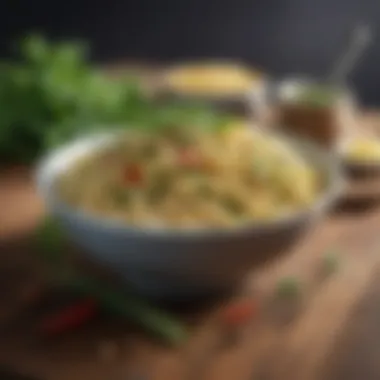

Vegetables
Common choices
Vegetables are essential for adding freshness and crunch to macaroni salad. Common choices include celery, bell peppers, onions, and diced carrots. Each adds a distinct texture and flavor. Fresh vegetables not only enhance the visual appeal but also contribute to nutritional value.
A unique feature of vegetables is their ability to absorb dressing flavors over time, making leftovers often tastier after a day in the fridge. It is essential to cut them into small, even pieces for consistent texture. Neglecting this step can lead to uneven bites in the salad.
Preparation methods
The preparation of vegetables is just as crucial as the choice of which vegetables to include. Dicing and chopping into uniform pieces ensure equal distribution in the salad. Sometimes, lightly steaming certain vegetables like carrots can soften them slightly while keeping their vibrant color and crunch.
Ensuring each vegetable is adequately prepared can impact the entire dish's taste and texture. Under-prepared vegetables may clash with the softness of pasta, leading to a less enjoyable eating experience.
Protein Additions
Types of proteins
Adding protein can transform macaroni salad into a more fulfilling meal. Common protein additions include diced ham, chicken, or even chickpeas for a vegetarian option. Each type brings its flavor, texture, and nutritional benefits. Diced proteins also create a more balanced dish by complementing the carbohydrates found in pasta.
A unique feature of protein additions is the diverse flavor profiles they provide. Choosing the right protein can significantly enhance the overall taste. However, overly assertive flavors may compete with the other components of the salad, thus careful selection is important.
Flavor considerations
Considering how proteins impact flavor is crucial when preparing macaroni salad. Some proteins, like smoked ham, can impart a strong flavor that may overshadow other ingredients. Balancing these flavors is essential to create a well-rounded dish. The main characteristic of considering flavor is ensuring all elements harmonize rather than compete.
Understanding how each ingredient interacts on the palate can result in a more satisfying taste experience. Inadequate pairing can detract from the overall quality of the salad, so thoughtful selection is key.
Herbs and Seasonings
Fresh herbs
Incorporating fresh herbs into macaroni salad elevates the dish's flavor. Common choices include parsley, dill, and chives, each adding unique notes. Fresh herbs can brighten the overall taste and add layers of complexity.
A key characteristic of fresh herbs is their aromatic appeal. They can enhance the freshness of salads effectively. However, overusing strong herbs can dominate the dish and lead to an unpleasant taste.
Spices and their impact
Spices can greatly influence the flavor profile of macaroni salad. Mustard, pepper, and paprika are popular choices that add depth. These spices can highlight other elements without overwhelming the dish. They offer variability that can tailor the salad according to personal taste.
The unique feature of spices is their ability to enhance flavors subtly. A pinch of the right spice can elevate the dish significantly, but one must carefully measure to avoid overpowering the primary ingredients. Understanding the right balance of spices can determine the success of the macaroni salad.
Variations of Macaroni Salad
Variations of macaroni salad are important for several reasons. They allow cooks to tailor the dish according to specific tastes and dietary needs. Different variations can elevate the standard macaroni salad, transforming it into a meal suitable for various occasions. From classic to innovative recipes, each variation houses unique flavors and ingredients. This variety enhances enjoyment while also providing a means to explore culinary creativity. This section will examine some popular variations and their components, giving insight into what makes each one special.
Classic American Macaroni Salad
Traditional ingredients
The traditional ingredients of American macaroni salad include macaroni pasta, mayonnaise, hard-boiled eggs, celery, and spices. Each of these elements contributes to a creamy and satisfying dish. The key characteristic of these traditional ingredients is their accessibility and familiarity. This makes them a popular choice among families and gatherings. The unique feature is their balanced flavor profile; the creaminess of mayonnaise pairs well with the crispness of celery. One disadvantage may be that this classic version can lack innovation for those looking to try something new.
Serving suggestions
Serving suggestions for classic macaroni salad play a crucial role in presentation. Typically, it is served chilled in a bowl, garnished with a sprinkle of paprika or fresh herbs. This adds a visual appeal, enhancing the eating experience. One key characteristic of these suggestions is their simplicity; they require minimal effort while making the dish more appetizing. The unique feature here is the ability to personalize serving styles. For instance, serving in individual cups can make it ideal for picnics. However, the straightforward presentation may not stand out at more formal events.
Mediterranean Influences
Ingredients specific to the region
Mediterranean macaroni salad introduces ingredients like olives, feta cheese, cherry tomatoes, and artichokes. These ingredients add rich, diverse flavors that contrast the traditional American version. A key characteristic of Mediterranean influences is their emphasis on fresh and vibrant components. This choice is beneficial for those seeking to add a refreshing twist to their salad. The unique feature of this variation is the use of herbs like basil or oregano, which imbue the salad with aromatic complexities. However, not everyone may enjoy the tangy taste of feta or the brininess of olives.
Texture and taste changes
The texture and taste changes between classic and Mediterranean styles are noticeable. While American macaroni salad is creamy and dense, the Mediterranean version tends to be lighter and more textured due to the incorporation of fresh vegetables and cheese. This is beneficial as it makes the dish feel more vibrant and less heavy. The distinct characteristics, such as the crunch from fresh vegetables or the chewiness of olives, enhance the overall salad experience. However, some might find that the mix of subtler flavors can be overshadowed if combined improperly, potentially impacting the dish's overall integrity.
Health-Conscious Alternatives
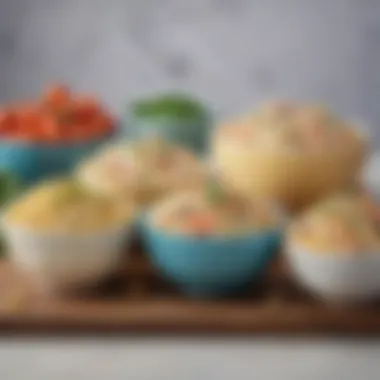

Low-fat and light dressings
Low-fat and light dressings are becoming more popular in macaroni salads, offering a healthier alternative to traditional mayonnaise. These options often include yogurt, pesto, or vinaigrettes, providing a tasty yet lower-calorie solution. A key characteristic of these dressings is their ability to retain flavor while reducing fat content. The benefit is clear; they cater to health-conscious eaters without sacrificing taste. However, a unique feature is that some may miss the creaminess of full-fat mayonnaise, potentially leading to a less satisfying texture.
Substituting ingredients for nutrition
Substituting ingredients for nutrition is another smart approach to macaroni salad. For instance, whole-grain pasta can replace regular macaroni for added fiber, while vegetables like spinach or kale can enhance nutrients. This approach emphasizes the importance of health in meal preparation, helping to align diets with personal wellness goals. A beneficial aspect is the enhanced nutritional profile, making the dish more wholesome overall. The unique feature of blending in such ingredients allows for creativity, but one potential downside is that not all substitutes will appeal to everyone’s taste preferences.
Common Mistakes in Preparing Macaroni Salad
When it comes to preparing macaroni salad, achieving the perfect balance of flavors and textures can be a challenge. Often, the distinction between a delightful dish and a disappointing one lies in a few common mistakes. Understanding these pitfalls aids in creating a macaroni salad that not only satisfies the palate but also impresses those who share in the meal. This section will spotlight three significant areas where errors frequently occur: overcooking pasta, inadequate seasoning, and imbalanced ingredient ratios.
Overcooking Pasta
Overcooked pasta is the nemesis of macaroni salad. Ideally, the macaroni should have a firm texture, known as "al dente." This slight firmness helps the pasta maintain its shape and texture when mixed with dressing and other ingredients. If cooked too long, macaroni can become mushy and lose its integrity. This results in a salad that lacks structure.
To avoid this mistake, attention is needed when boiling the pasta. Follow the instructions on the package regarding cooking times. You can also taste the pasta a minute or two before the indicated time. Once the macaroni is cooked to your liking, drain it immediately and rinse under cold water. This stops the cooking process and helps to firm up the pasta further.
Inadequate Seasoning
The importance of seasoning cannot be overstated in any culinary endeavor. In the context of macaroni salad, inadequate seasoning can lead to a bland outcome. While the salad dressing often carries much of the flavor, the pasta and vegetables themselves also need attention.
A practical approach involves salting the water used for boiling pasta. This enhances the flavor of the pasta itself. Moreover, when mixing in the dressing, consider adding other seasonings such as salt, pepper, and even a squeeze of lemon juice for brightness. Ingredients like celery, onions, or pickles also benefit from seasoning. Tasting frequently while preparing allows you to adjust the flavors accordingly.
Imbalanced Ingredient Ratios
Each component of macaroni salad plays a vital role in its overall taste and texture. An imbalance, whether too much dressing, too many vegetables, or excessive protein, can detract from the dish. It can create a salad that is overly creamy, too dry, or lacks a distinctive flavor profile.
When assembling your salad, it's important to adhere to a balanced ratio. For example, if you are using about two cups of cooked macaroni, aim for roughly one cup of vegetables, and adjust the dressing to coat the ingredients without overpowering them. Take care to visually assess and adjust the components as needed, ensuring that each ingredient contributes to the final dish's flavor and presentation.
"Proportion is key in achieving a harmonious macaroni salad that tantalizes the taste buds."
By keeping these common mistakes in mind, anyone can create a macaroni salad that stands out. Awareness of overcooking pasta, seasoning adequately, and maintaining balanced ingredient ratios will elevate the overall quality of the dish. As with any culinary process, striking a balance helps transform a simple recipe into an extraordinary meal.
Serving and Storage Recommendations
Understanding the serving and storage recommendations for macaroni salad is crucial. This section provides guidance on how to maintain the dish's quality over time. Correct serving practices can enhance the eating experience, while proper storage can extend freshness.
Right Temperature for Serving
The serving temperature of macaroni salad plays a significant role in its overall appeal. Ideally, macaroni salad should be served chilled. This enhances the flavors and provides a refreshing contrast, especially during warmer months. The right temperature can make the textures more enjoyable, allowing the creaminess of the dressing to complement the pasta and vegetables effectively.
When serving, aim for a temperature between 35°F to 50°F (1°C to 10°C). Serving at this range helps to preserve the integrity of the lettuce and other crisp vegetables, keeping them from wilting. Too warm, and the salad may become overly soggy, leading to a less appetizing result.
Storage Techniques
Proper storage techniques are essential to ensure the longevity of your macaroni salad. Once prepared, the salad should be stored in an airtight container. This prevents exposure to air, which can lead to spoilage and loss of flavor. Placing a layer of plastic wrap directly on the surface of the salad before sealing the container can further minimize oxidation.
Macaroni salad can usually be stored in the refrigerator for three to five days. It's important to keep the salad at a constant temperature below 40°F (4°C). If left unrefrigerated for more than two hours, it is advisable to discard it to prevent any risk of foodborne illnesses.
To maintain freshness, consider the following tips:
- Refrigerate promptly: Always put leftovers in the fridge within two hours of serving.
- Avoid freezing: Macaroni salad does not freeze well, as the texture can become mushy once thawed.
- Separate dressing: If making the salad ahead of time, store the dressing separately and mix it just before serving to prevent sogginess.
By following these serving and storage recommendations, you can enjoy macaroni salad at its best, maximizing both flavor and safety.
Finale
In wrapping up our exploration of macaroni salad, it is crucial to reflect on the significance of understanding the key ingredients. The assortment of elements not only shapes the overall flavor profile but also determines the texture of the dish. Selecting high-quality macaroni, a well-balanced dressing, and fresh vegetables can greatly enhance the enjoyment of this classic salad. Each ingredient plays a role in contributing to a harmonious dish that appeals to diverse palates.
Recap of Key Ingredients
When preparing macaroni salad, there are a few essential ingredients to keep in mind.
- Macaroni Pasta: The foundation of the salad. Various types are available, such as elbow macaroni and cavatappi. Cooking it properly is vital for an ideal texture.
- Salad Dressing: This can make or break the dish. You may choose from mayonnaise-based or vinegar-based dressings. Each approach offers a different taste experience.
- Vegetables: Common choices include celery, bell peppers, and onions. Their preparation, either raw or lightly cooked, adds freshness.
- Protein Additions: Chicken, shrimp, or tuna are common. These provide substance and can influence overall taste.
- Herbs and Seasonings: Fresh herbs like dill or parsley enhance flavors. A judicious use of spices can elevate the dish without overwhelming it.
Incorporating these elements effectively will lead to a macaroni salad that will likely be appreciated by all who try it.
Encouragement for Variation
Encouragement for variation is a necessary reminder for anyone looking to create their own version of macaroni salad. This dish is highly flexible. You can easily adjust ingredients based on your preferences or dietary restrictions. For instance, using whole wheat pasta or low-fat dressings can cater to those seeking healthier options.
Experimentation is encouraged. Consider adding fruits like apples or grapes for a contrasting flavor that brightens the dish. Alternatively, a blend of cheeses can add richness that contrasts with the acidity of the dressing. Each subtle change can yield a uniquely satisfying result.




